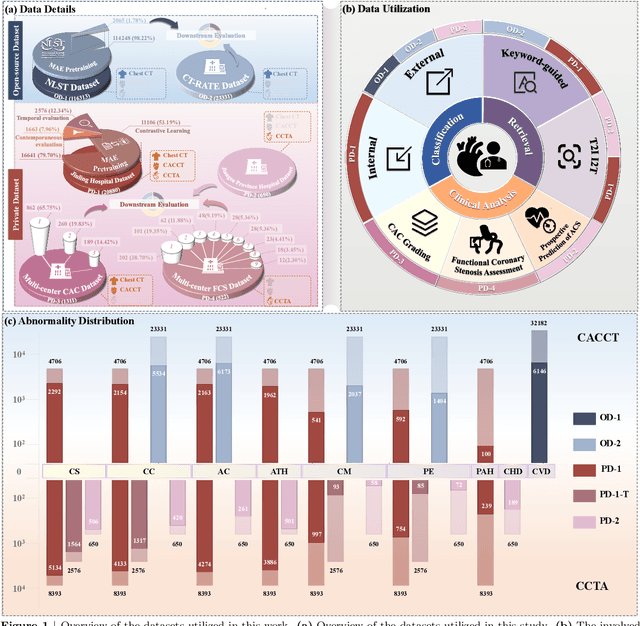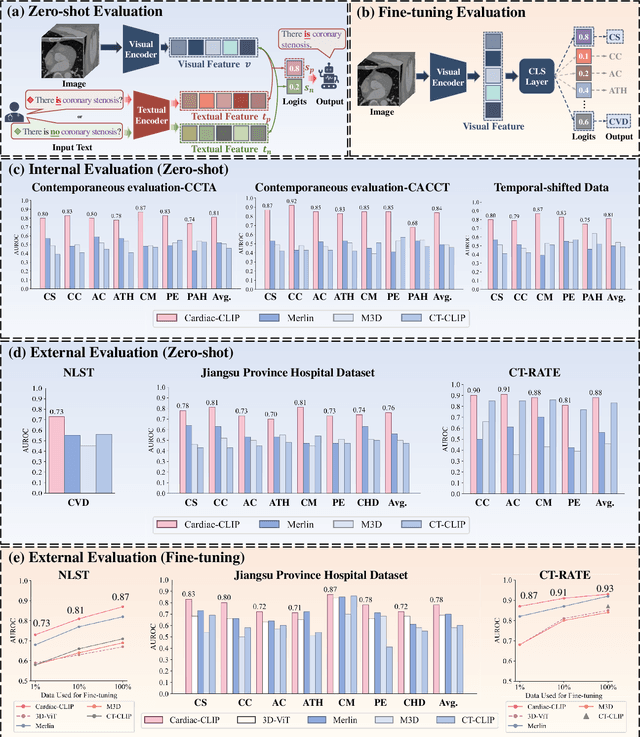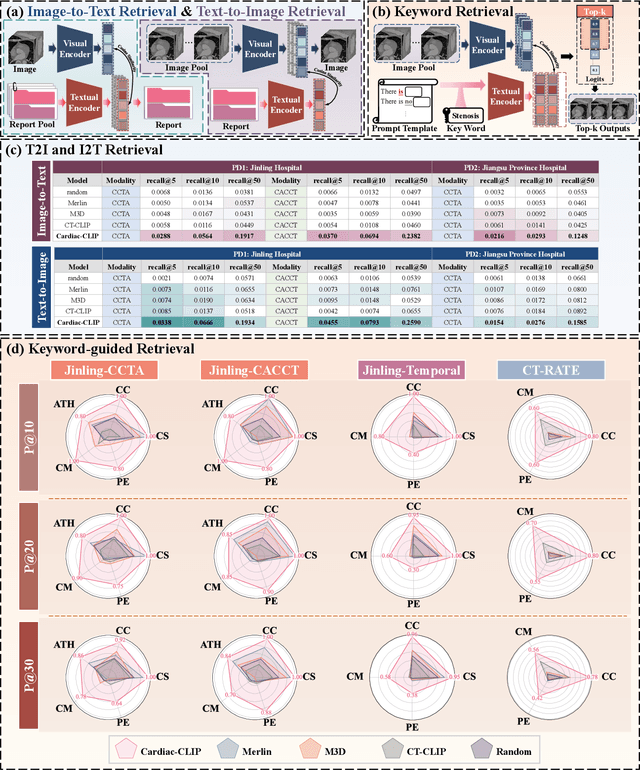Text Classification
Text classification is the process of categorizing text documents into predefined categories or labels.
Papers and Code
Cardiac-CLIP: A Vision-Language Foundation Model for 3D Cardiac CT Images
Jul 29, 2025



Foundation models have demonstrated remarkable potential in medical domain. However, their application to complex cardiovascular diagnostics remains underexplored. In this paper, we present Cardiac-CLIP, a multi-modal foundation model designed for 3D cardiac CT images. Cardiac-CLIP is developed through a two-stage pre-training strategy. The first stage employs a 3D masked autoencoder (MAE) to perform self-supervised representation learning from large-scale unlabeled volumetric data, enabling the visual encoder to capture rich anatomical and contextual features. In the second stage, contrastive learning is introduced to align visual and textual representations, facilitating cross-modal understanding. To support the pre-training, we collect 16641 real clinical CT scans, supplemented by 114k publicly available data. Meanwhile, we standardize free-text radiology reports into unified templates and construct the pathology vectors according to diagnostic attributes, based on which the soft-label matrix is generated to supervise the contrastive learning process. On the other hand, to comprehensively evaluate the effectiveness of Cardiac-CLIP, we collect 6,722 real-clinical data from 12 independent institutions, along with the open-source data to construct the evaluation dataset. Specifically, Cardiac-CLIP is comprehensively evaluated across multiple tasks, including cardiovascular abnormality classification, information retrieval and clinical analysis. Experimental results demonstrate that Cardiac-CLIP achieves state-of-the-art performance across various downstream tasks in both internal and external data. Particularly, Cardiac-CLIP exhibits great effectiveness in supporting complex clinical tasks such as the prospective prediction of acute coronary syndrome, which is notoriously difficult in real-world scenarios.
Uncertainty-driven Embedding Convolution
Jul 28, 2025Text embeddings are essential components in modern NLP pipelines. While numerous embedding models have been proposed, their performance varies across domains, and no single model consistently excels across all tasks. This variability motivates the use of ensemble techniques to combine complementary strengths. However, most existing ensemble methods operate on deterministic embeddings and fail to account for model-specific uncertainty, limiting their robustness and reliability in downstream applications. To address these limitations, we propose Uncertainty-driven Embedding Convolution (UEC). UEC first transforms deterministic embeddings into probabilistic ones in a post-hoc manner. It then computes adaptive ensemble weights based on embedding uncertainty, grounded in a Bayes-optimal solution under a surrogate loss. Additionally, UEC introduces an uncertainty-aware similarity function that directly incorporates uncertainty into similarity scoring. Extensive experiments on retrieval, classification, and semantic similarity benchmarks demonstrate that UEC consistently improves both performance and robustness by leveraging principled uncertainty modeling.
MGFFD-VLM: Multi-Granularity Prompt Learning for Face Forgery Detection with VLM
Jul 16, 2025



Recent studies have utilized visual large language models (VLMs) to answer not only "Is this face a forgery?" but also "Why is the face a forgery?" These studies introduced forgery-related attributes, such as forgery location and type, to construct deepfake VQA datasets and train VLMs, achieving high accuracy while providing human-understandable explanatory text descriptions. However, these methods still have limitations. For example, they do not fully leverage face quality-related attributes, which are often abnormal in forged faces, and they lack effective training strategies for forgery-aware VLMs. In this paper, we extend the VQA dataset to create DD-VQA+, which features a richer set of attributes and a more diverse range of samples. Furthermore, we introduce a novel forgery detection framework, MGFFD-VLM, which integrates an Attribute-Driven Hybrid LoRA Strategy to enhance the capabilities of Visual Large Language Models (VLMs). Additionally, our framework incorporates Multi-Granularity Prompt Learning and a Forgery-Aware Training Strategy. By transforming classification and forgery segmentation results into prompts, our method not only improves forgery classification but also enhances interpretability. To further boost detection performance, we design multiple forgery-related auxiliary losses. Experimental results demonstrate that our approach surpasses existing methods in both text-based forgery judgment and analysis, achieving superior accuracy.
HQ-CLIP: Leveraging Large Vision-Language Models to Create High-Quality Image-Text Datasets and CLIP Models
Jul 30, 2025Large-scale but noisy image-text pair data have paved the way for the success of Contrastive Language-Image Pretraining (CLIP). As the foundation vision encoder, CLIP in turn serves as the cornerstone for most large vision-language models (LVLMs). This interdependence naturally raises an interesting question: Can we reciprocally leverage LVLMs to enhance the quality of image-text pair data, thereby opening the possibility of a self-reinforcing cycle for continuous improvement? In this work, we take a significant step toward this vision by introducing an LVLM-driven data refinement pipeline. Our framework leverages LVLMs to process images and their raw alt-text, generating four complementary textual formulas: long positive descriptions, long negative descriptions, short positive tags, and short negative tags. Applying this pipeline to the curated DFN-Large dataset yields VLM-150M, a refined dataset enriched with multi-grained annotations. Based on this dataset, we further propose a training paradigm that extends conventional contrastive learning by incorporating negative descriptions and short tags as additional supervised signals. The resulting model, namely HQ-CLIP, demonstrates remarkable improvements across diverse benchmarks. Within a comparable training data scale, our approach achieves state-of-the-art performance in zero-shot classification, cross-modal retrieval, and fine-grained visual understanding tasks. In retrieval benchmarks, HQ-CLIP even surpasses standard CLIP models trained on the DFN-2B dataset, which contains 10$\times$ more training data than ours. All code, data, and models are available at https://zxwei.site/hqclip.
RingMo-Agent: A Unified Remote Sensing Foundation Model for Multi-Platform and Multi-Modal Reasoning
Jul 28, 2025



Remote sensing (RS) images from multiple modalities and platforms exhibit diverse details due to differences in sensor characteristics and imaging perspectives. Existing vision-language research in RS largely relies on relatively homogeneous data sources. Moreover, they still remain limited to conventional visual perception tasks such as classification or captioning. As a result, these methods fail to serve as a unified and standalone framework capable of effectively handling RS imagery from diverse sources in real-world applications. To address these issues, we propose RingMo-Agent, a model designed to handle multi-modal and multi-platform data that performs perception and reasoning tasks based on user textual instructions. Compared with existing models, RingMo-Agent 1) is supported by a large-scale vision-language dataset named RS-VL3M, comprising over 3 million image-text pairs, spanning optical, SAR, and infrared (IR) modalities collected from both satellite and UAV platforms, covering perception and challenging reasoning tasks; 2) learns modality adaptive representations by incorporating separated embedding layers to construct isolated features for heterogeneous modalities and reduce cross-modal interference; 3) unifies task modeling by introducing task-specific tokens and employing a token-based high-dimensional hidden state decoding mechanism designed for long-horizon spatial tasks. Extensive experiments on various RS vision-language tasks demonstrate that RingMo-Agent not only proves effective in both visual understanding and sophisticated analytical tasks, but also exhibits strong generalizability across different platforms and sensing modalities.
Leveraging Pre-Trained Visual Models for AI-Generated Video Detection
Jul 17, 2025



Recent advances in Generative AI (GenAI) have led to significant improvements in the quality of generated visual content. As AI-generated visual content becomes increasingly indistinguishable from real content, the challenge of detecting the generated content becomes critical in combating misinformation, ensuring privacy, and preventing security threats. Although there has been substantial progress in detecting AI-generated images, current methods for video detection are largely focused on deepfakes, which primarily involve human faces. However, the field of video generation has advanced beyond DeepFakes, creating an urgent need for methods capable of detecting AI-generated videos with generic content. To address this gap, we propose a novel approach that leverages pre-trained visual models to distinguish between real and generated videos. The features extracted from these pre-trained models, which have been trained on extensive real visual content, contain inherent signals that can help distinguish real from generated videos. Using these extracted features, we achieve high detection performance without requiring additional model training, and we further improve performance by training a simple linear classification layer on top of the extracted features. We validated our method on a dataset we compiled (VID-AID), which includes around 10,000 AI-generated videos produced by 9 different text-to-video models, along with 4,000 real videos, totaling over 7 hours of video content. Our evaluation shows that our approach achieves high detection accuracy, above 90% on average, underscoring its effectiveness. Upon acceptance, we plan to publicly release the code, the pre-trained models, and our dataset to support ongoing research in this critical area.
TransLPRNet: Lite Vision-Language Network for Single/Dual-line Chinese License Plate Recognition
Jul 23, 2025License plate recognition in open environments is widely applicable across various domains; however, the diversity of license plate types and imaging conditions presents significant challenges. To address the limitations encountered by CNN and CRNN-based approaches in license plate recognition, this paper proposes a unified solution that integrates a lightweight visual encoder with a text decoder, within a pre-training framework tailored for single and double-line Chinese license plates. To mitigate the scarcity of double-line license plate datasets, we constructed a single/double-line license plate dataset by synthesizing images, applying texture mapping onto real scenes, and blending them with authentic license plate images. Furthermore, to enhance the system's recognition accuracy, we introduce a perspective correction network (PTN) that employs license plate corner coordinate regression as an implicit variable, supervised by license plate view classification information. This network offers improved stability, interpretability, and low annotation costs. The proposed algorithm achieves an average recognition accuracy of 99.34% on the corrected CCPD test set under coarse localization disturbance. When evaluated under fine localization disturbance, the accuracy further improves to 99.58%. On the double-line license plate test set, it achieves an average recognition accuracy of 98.70%, with processing speeds reaching up to 167 frames per second, indicating strong practical applicability.
How Effectively Can BERT Models Interpret Context and Detect Bengali Communal Violent Text?
Jun 24, 2025The spread of cyber hatred has led to communal violence, fueling aggression and conflicts between various religious, ethnic, and social groups, posing a significant threat to social harmony. Despite its critical importance, the classification of communal violent text remains an underexplored area in existing research. This study aims to enhance the accuracy of detecting text that incites communal violence, focusing specifically on Bengali textual data sourced from social media platforms. We introduce a fine-tuned BanglaBERT model tailored for this task, achieving a macro F1 score of 0.60. To address the issue of data imbalance, our dataset was expanded by adding 1,794 instances, which facilitated the development and evaluation of a fine-tuned ensemble model. This ensemble model demonstrated an improved performance, achieving a macro F1 score of 0.63, thus highlighting its effectiveness in this domain. In addition to quantitative performance metrics, qualitative analysis revealed instances where the models struggled with context understanding, leading to occasional misclassifications, even when predictions were made with high confidence. Through analyzing the cosine similarity between words, we identified certain limitations in the pre-trained BanglaBERT models, particularly in their ability to distinguish between closely related communal and non-communal terms. To further interpret the model's decisions, we applied LIME, which helped to uncover specific areas where the model struggled in understanding context, contributing to errors in classification. These findings highlight the promise of NLP and interpretability tools in reducing online communal violence. Our work contributes to the growing body of research in communal violence detection and offers a foundation for future studies aiming to refine these techniques for better accuracy and societal impact.
FRaN-X: FRaming and Narratives-eXplorer
Jul 09, 2025We present FRaN-X, a Framing and Narratives Explorer that automatically detects entity mentions and classifies their narrative roles directly from raw text. FRaN-X comprises a two-stage system that combines sequence labeling with fine-grained role classification to reveal how entities are portrayed as protagonists, antagonists, or innocents, using a unique taxonomy of 22 fine-grained roles nested under these three main categories. The system supports five languages (Bulgarian, English, Hindi, Russian, and Portuguese) and two domains (the Russia-Ukraine Conflict and Climate Change). It provides an interactive web interface for media analysts to explore and compare framing across different sources, tackling the challenge of automatically detecting and labeling how entities are framed. Our system allows end users to focus on a single article as well as analyze up to four articles simultaneously. We provide aggregate level analysis including an intuitive graph visualization that highlights the narrative a group of articles are pushing. Our system includes a search feature for users to look up entities of interest, along with a timeline view that allows analysts to track an entity's role transitions across different contexts within the article. The FRaN-X system and the trained models are licensed under an MIT License. FRaN-X is publicly accessible at https://fran-x.streamlit.app/ and a video demonstration is available at https://youtu.be/VZVi-1B6yYk.
Inverse Scene Text Removal
Jun 26, 2025Scene text removal (STR) aims to erase textual elements from images. It was originally intended for removing privacy-sensitiveor undesired texts from natural scene images, but is now also appliedto typographic images. STR typically detects text regions and theninpaints them. Although STR has advanced through neural networksand synthetic data, misuse risks have increased. This paper investi-gates Inverse STR (ISTR), which analyzes STR-processed images andfocuses on binary classification (detecting whether an image has un-dergone STR) and localizing removed text regions. We demonstrate inexperiments that these tasks are achievable with high accuracies, en-abling detection of potential misuse and improving STR. We also at-tempt to recover the removed text content by training a text recognizerto understand its difficulty.
 Add to Chrome
Add to Chrome Add to Firefox
Add to Firefox Add to Edge
Add to Edge